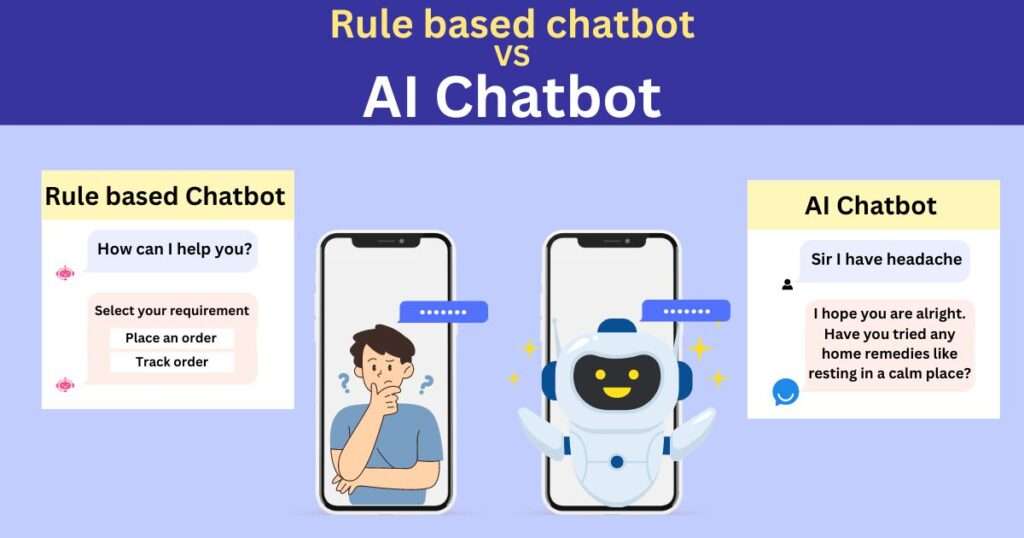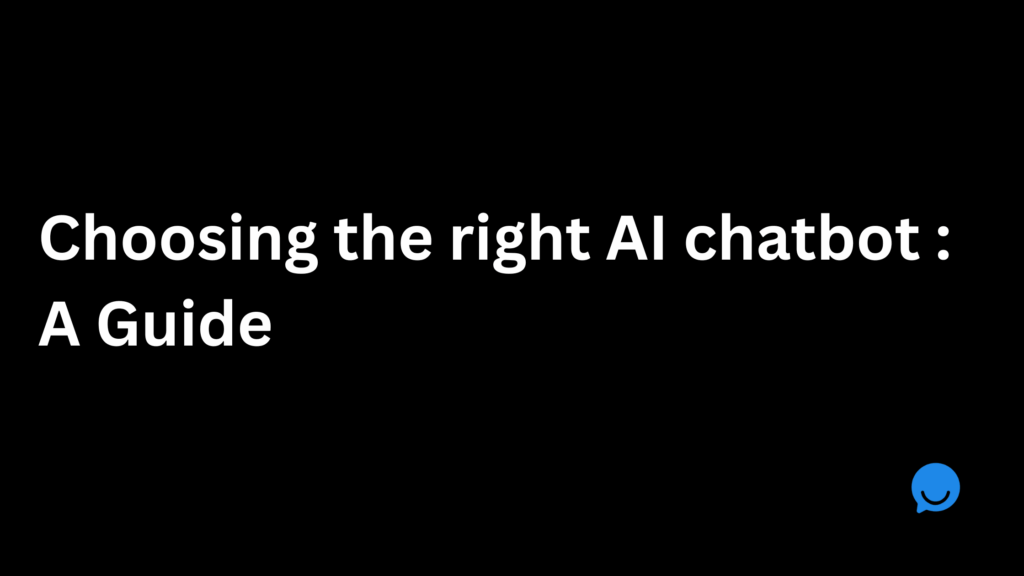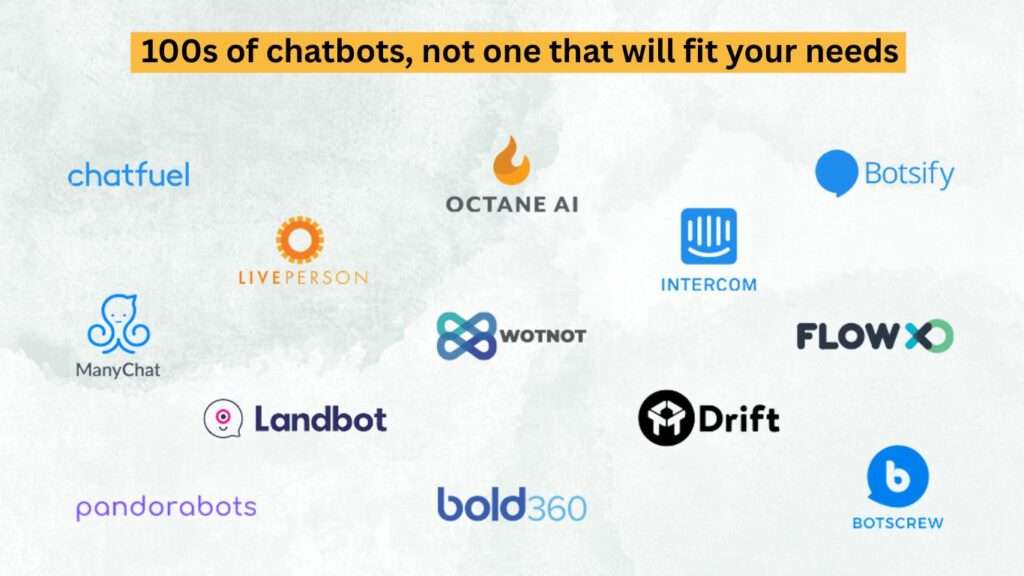Ever heard of chatbots? They’re like your digital buddies you can talk to whenever you need help with something. Pretty cool, right?
So, there are these two main types of chatbots: rule-based chatbots and AI chatbot.
But what’s the difference? Rule-based ones are kinda like robots following a set of instructions. They can only do what they’ve been programmed to do, so they’re pretty straightforward. On the flip side, we’ve got AI chatbots. These ones are like super-smart buddies who use fancy technology called artificial intelligence to understand what you’re saying and learn from it. They’re like the brainiacs of the chatbot world!
But do you know how they get so smart? Now, here’s the million-dollar question: why does it even matter to know the difference between rule-based and AI chatbots? Well, think about it. Understanding the different types can help you pick the right one for what you need. Whether you’re looking for something simple and predictable or you want a chatbot that can adapt and learn with you, knowing the basics can help you make the best choice. Cool, huh?

Rule-based chatbots vs AI chatbots:
So, let’s understand rule-based chatbots better. These bots work like obedient little machines—they follow a set of rules like a script. So, when you ask them a question or give them a command, they check their rulebook and spit out a pre-written response. It’s kind of like talking to a really polite robot!
But here’s the thing: because they’re so rule-bound, they’re not the best at handling anything outside of their programmed rules. So, if you ask them something they don’t understand, they might get a little confused. On the flip side, rule-based chatbots are pretty reliable for simple tasks with clear-cut answers. So, while they might not be the most flexible, they’re great for handling routine stuff without breaking a sweat.
Now, let’s talk about AI chatbots—the brainiacs of the chatbot world! These bots are like the cool kids who always seem to have the answer to everything. Instead of following rigid rules, they use cutting-edge technology called artificial intelligence (AI) and machine learning to understand and respond to your queries.
It’s like they’re constantly learning and getting smarter with every interaction, just like a real conversation with a friend! This means they’re super flexible and adaptive. They can handle all sorts of different tasks and even pick up on nuances in language, making them great at understanding your needs and providing helpful responses. So, whether you’re asking them a simple question or throwing them a curveball, AI chatbots are up for the challenge!
Pros and Cons of Rule-based and AI chatbot:
Now, let’s talk pros and cons. Rule-based chatbots are fantastic for their simplicity and reliability. They’re easy to set up and can handle straightforward tasks efficiently. However, they lack the ability to adapt to new situations and may struggle with handling more complex queries.
Meanwhile, AI chatbots like Beyondchats are the superheroes of adaptability and intelligence. They can learn from user interactions, providing personalized responses and improving over time. However, they require more resources to develop and may be more complex to implement compared to rule-based chatbots.
In summary, both types of chatbots have their strengths and weaknesses, and the choice between them depends on the specific needs and requirements of the task at hand.
How to choose between Rule-based chatbot and AI chatbot?
First, when choosing between the two, there are a few key factors to consider. Think about the complexity of the tasks you need the chatbot to handle. A rule-based chatbot might do the trick if it’s something straightforward like answering frequently asked questions. Learn more about Rule based chatbots.
But if you need something more sophisticated, like personalized recommendations or natural language understanding, you’ll probably want to go with an AI chatbot.
Next up, let’s talk development and deployment. Rule-based chatbots are generally easier and quicker to develop since they rely on predefined rules. You can get one up and running pretty quickly with minimal coding. On the other hand, AI chatbots require more advanced technology and expertise to develop, so the development process may take longer and require a larger investment of time and resources. Additionally, deployment considerations may vary depending on the complexity of the chatbot and the infrastructure required to support it.
Last but not least, let’s talk about everyone’s favorite topic: cost and resources. Rule-based chatbots tend to be more cost-effective upfront since they’re simpler to develop and deploy. However, they may require ongoing maintenance and updates to keep them running smoothly. AI chatbots, on the other hand, may have higher initial development costs due to the complexity of the technology involved. However, they can often provide more value in the long run through their ability to learn and adapt to new situations.
In the end, the choice between rule-based and AI chatbots depends on your specific needs, resources, and objectives. It’s essential to carefully consider all these factors before making a decision to ensure that you choose the right solution for your organization.
What are the future trends?
Starting with rule-based chatbots, we might see advancements in their ability to handle more complex tasks. While they may never reach the same level of sophistication as AI chatbots, improvements in natural language processing and decision-making algorithms could make them more capable of handling a broader range of queries. Additionally, we might see increased integration with other technologies, such as voice recognition and sentiment analysis, to enhance the user experience.
As for AI chatbots, the sky’s the limit! One of the most exciting emerging trends is the use of conversational AI, which aims to create chatbots that can engage in more natural, human-like conversations. This could involve advancements in language understanding, context awareness, and emotional intelligence, making interactions with AI chatbots feel more intuitive and personalized. We might also see increased use of AI chatbots in areas like virtual assistants, healthcare, and education, where their ability to learn and adapt can provide significant benefits.
So, what does all this mean for businesses and users? Well, for businesses, it means opportunities to streamline operations, enhance customer experiences, and drive innovation. Chatbots can automate routine tasks, provide personalized support, and gather valuable insights from user interactions. For users, it means access to more efficient and convenient services, whether it’s getting instant answers to questions, receiving personalized recommendations, or accessing support around the clock. As chatbot technology continues to evolve, businesses and users alike stand to benefit from its increasing capabilities and applications.
Conclusion
To sum it all up, we’ve explored the key differences between rule-based and AI chatbots, from their technology and capabilities to their strengths and weaknesses. We’ve also discussed important factors to consider when choosing between the two, such as the complexity of tasks, development considerations, and cost implications. It’s essential to weigh these factors carefully to ensure that you select the right type of chatbot for your specific needs and objectives.
Selecting the right chatbot can make a significant difference in the efficiency and effectiveness of your operations, whether you’re looking to provide better customer support, automate repetitive tasks, or improve user experiences. By understanding the unique capabilities and limitations of rule-based and AI chatbots, you can make an informed decision that aligns with your goals and objectives.
Looking ahead, the future of chatbot technology looks bright. As advancements continue to be made in AI, natural language processing, and other related fields, we can expect to see chatbots become even more intelligent, intuitive, and versatile. This opens up exciting possibilities for businesses and users alike, from more personalized and responsive services to innovative applications in various industries.
In conclusion, whether you’re team rule-based or team AI, chatbots are here to stay—and they’re only getting better with time. So, embrace the possibilities, explore the opportunities, and get ready for a future where chatbots play an increasingly integral role in our lives.




